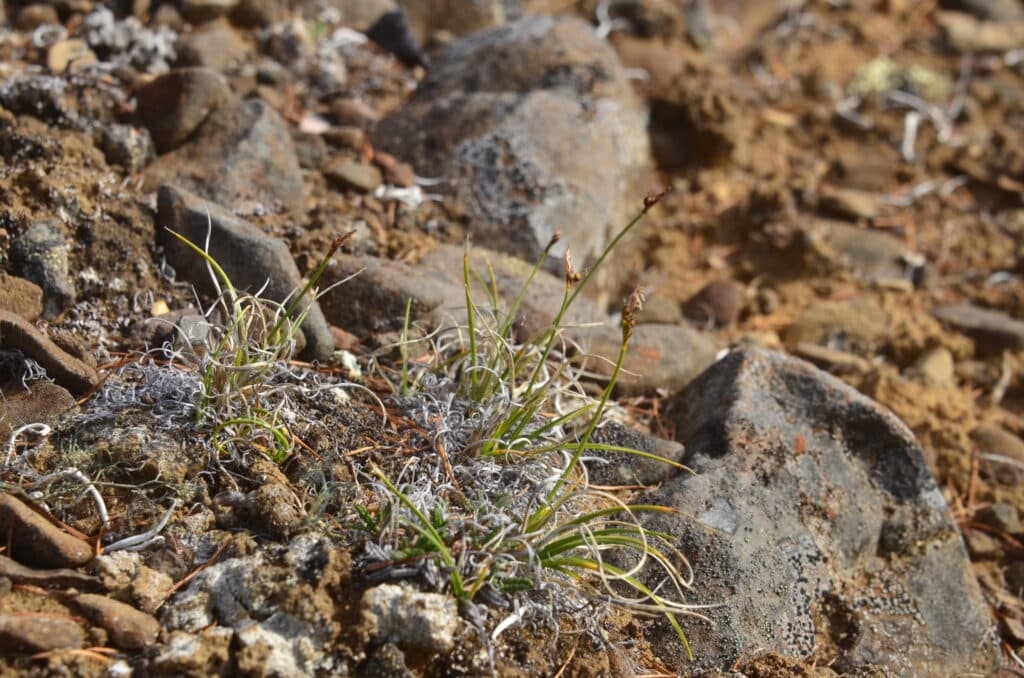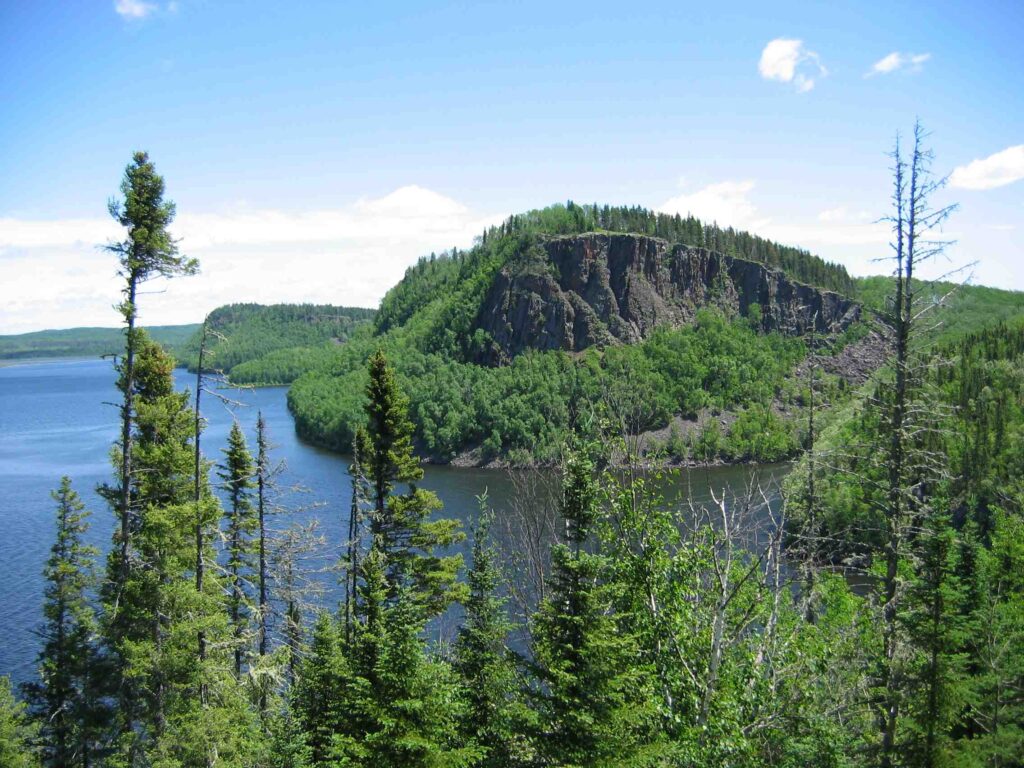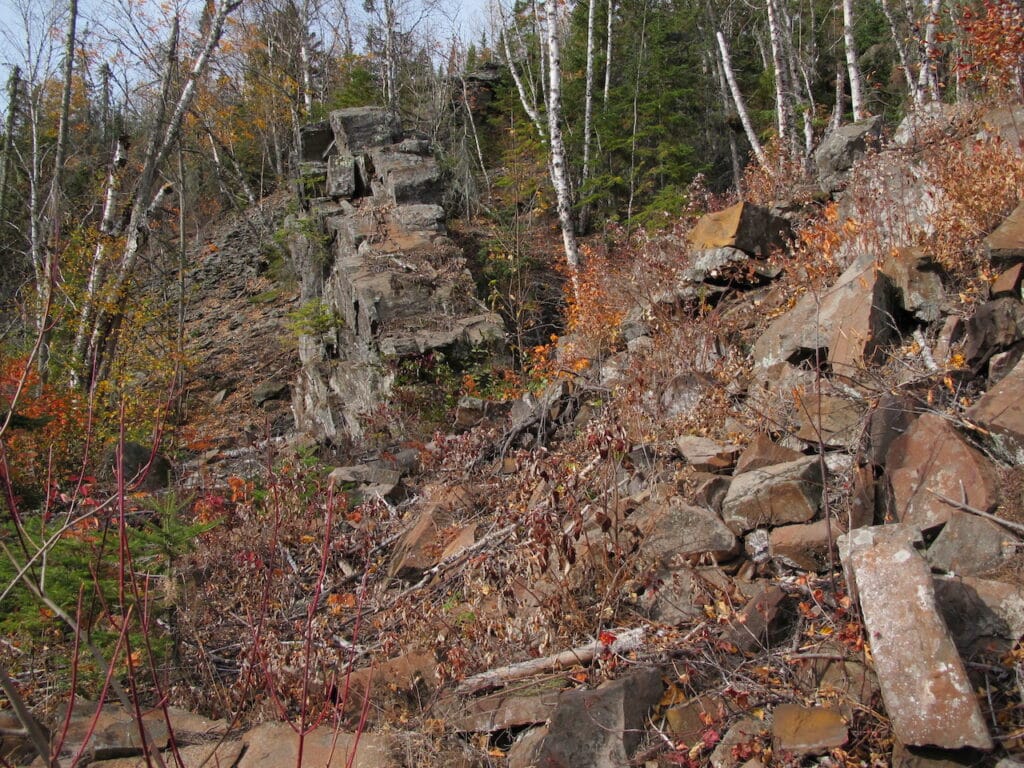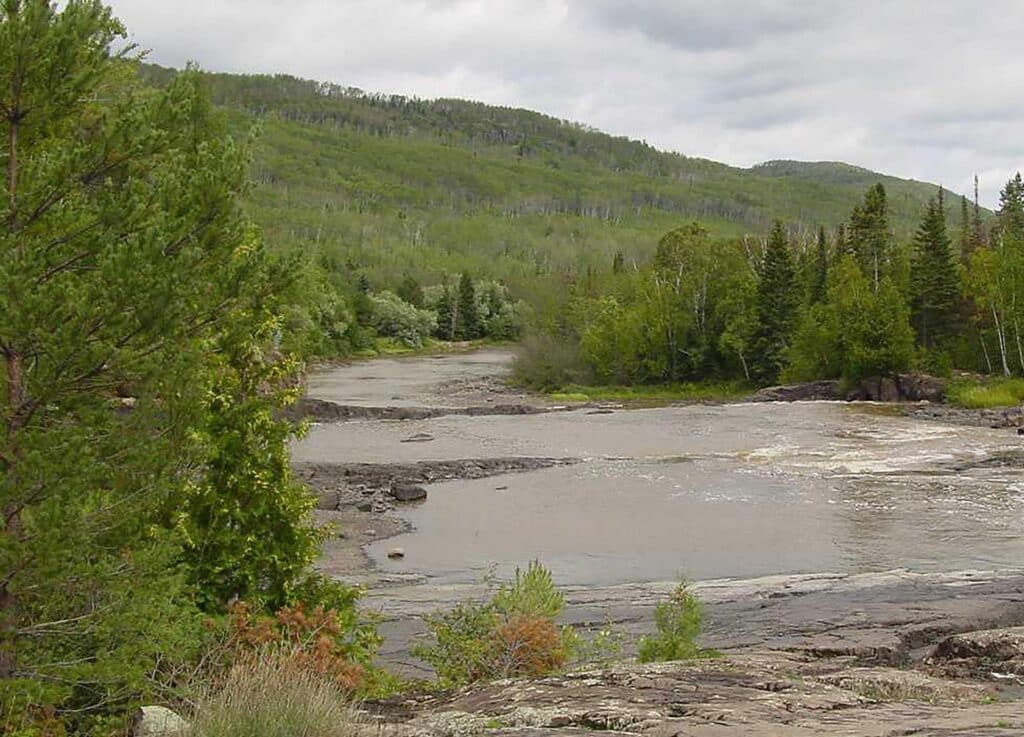
Tall cliffs soar over wild waters along the Pigeon River in northeastern Minnesota. Parallel sets of palisades create high ridges and deep valleys, with clear lakes at the lowest points. It forms a microclimate for a few rare plants, usually found much further north. This landscape was created over the course of more than a billion years, with glaciers carving sediments laid down when life on Earth was still microscopic and the continents were not yet complete.
The story began about 1.8 billion years ago, with shallow seas covering the area. The water slowly deposited deep layers of sediments that hardened into rock. Unlike much of what’s now the Boundary Waters and the Canadian Shield, this bedrock is sedimentary, not basalt created by volcanic activity. The sandstones and slates are not only softer than the typical canoe country rock, but also have less iron and taconite, and more carbonates. Veins of volcanic rock ran through the soft sedimentary rock.
When glaciers of the Ice Ages that have come and gone over the past two million years crossed the area, the ice carved out the sedimentary rock, leaving behind high ridges of basalt, glacial till, and remains of the slate. The area is unique in North America for having such scoured valleys that run perpendicular to the generally north-south movement of the glaciers.
Geologically, this area known as the Rove Formation. Recreationally, it’s a renowned part of the Boundary Waters Canoe Area Wilderness and the Superior National Forest, with campsites dotting shorelines and canoe routes cutting through the valleys. Popular lakes in what is known as the Vento Unit, north of the Gunflint Trail, include Rose, Clearwater, and Mountain.
These lakes are famous for their dramatic cliffs, and they are home to some very rare plants.

Arctic oasis
Because of the unique topography and the microclimates they create, species adapted to Far North climates can be found here on Minnesota’s northernmost lands. These plants were left behind by retreating ice sheets.
Minnesota was once essentially at the edge of the polar ice cap, and its landscape was rocky tundra. Plants grew here that now grow only in the currently coldest parts of Earth. Eventually, the tundra followed the ice as it retreated back toward the pole, over the span of thousands of years. Forests and grasslands gradually covered what’s now Minnesota. But on the north-facing cliffs, some tundra plants acted as if the glaciers were still nearby.
The carbonate bedrock here means the soil is more nutrient rich than over basalt, and because the valleys run east-west due to their glacial history, the cliffs mostly face north or south, and their climates take on extremes. The walls on the south shores, facing north, stay cool most of the year. They serve as portals to much more northern latitudes, refuge for species normally found in the Arctic and Subarctic regions.
Plants that fall into this category found in northern Minnesota’s Rove Formation include: meadow sedge, (Carex praticola), rough-fruited fairy bells (Prosartes trachycarpa), Taxus canadensis (Canada yew), blunt-fruited sweet cicely (Osmorhiza depauperata), maidenhair spleenwort (Asplenium trichomanes), large-leaved sandwort (Moehringia macrophylla), encrusted saxifrage (Saxifraga paniculata), Michigan moonwort (Botrychium michiganense), Purple Reedgrass (Calamagrostis purpurascens), Rocky Mountain Woodsia (Woodsia scopulina), and sticky locoweed (Oxytropis viscida).

Rewards of rediscovery
It’s not easy finding rare species among the broken slate of the palisades. Weak Arctic Sedge (Carex supina ssp. spaniocarpa) is the perfect example. It was first found on South Fowl Lake in 1889, and on a similar cliff on Clearwater Lake, 17 miles away, in 1936. A small green tuft, it’s easy to miss, especially when it’s not in bloom. Despite generations of botanists searching, no one laid eyes on the plant again until 2009.
That summer, scientists with the Minnesota Biological Survey, Lynden Gerdes and Michael Lee, were successful. After doing extensive research into the plant, the pair picked a Wednesday afternoon in early June to scramble around the cliff where the plant had first been found, on South Fowl Lake.
“Botanizing a cliff involves a constant assessment of which vertical chutes warrant climbing and which horizontal shelves and ledges permit closer investigation, an assessment of our safety and determination if our scrambling will cause damage to the cliffs fine, crumbly soils and vegetation,” Gerdes and Lee wrote.
But finding it was not easy. The tiny tuft of grass-like leaves are not flashy, the broken cliff face offers many inaccessible ledges and other hiding places. So the two botanists were thrilled when a clump matched the description.
“There on the side of the cliff, on this small isolated shelf, were more fine tufts of narrow leaved plants, some of these more mature with characteristic shiny, reddish-bronze perigynia,” they wrote. “It was then, amongst this cliff side population that we calmed ourselves long enough to fully observe the sedge and pull a copy of the Manual of Vascular Plants from our daypack.”
Carefully comparing the plants to the book, they confirmed the find. Its survival in this pocket of wilderness for the past 10,000 years is significant, and it could easily be wiped out. Confirming its presence in Minnesota lets experts plan for its preservation.

The next millennia
The Rove Formation is known in botany for its numerous rare plants. Most, like weak arctic sedge are the result of being stranded by retreating tundra. Located in a relatively remote location, the threats may be fewer. But there are still concerns for the unique ecosystem’s future.
“It is our hope that in 120 years from now, other botanists will have the privilege of experiencing the weak arctic sedge in Minnesota,” wrote the botanists Gerdes and Lee in 2009. “To find themselves perched on a small foothold, on the side of a grand cliff and overlook the beauty and serenity of the wilderness landscape of river, lake and forest below.”
The cliffs where the unique plants are found are mostly protected as public land, and much of it is in the wilderness, so the risk of development is low. But other human activities can do harm. Biologists have pointed to rock climbing as an activity than can threaten these isolated habitats, as climbers could trample plants and cause erosion. But local National Forest rangers say they’ve never seen climbing at the site, and it’s unlikely to become a destination.
Other human impacts could come from hikers on the Border Route Trail, which crosses the top of the ridge where weak arctic sedge was found, or snowmobiles traveling on a nearby trail at the foot of the cliffs.
To help ensure the long-term preservation of these unique habitats, the rare plants have been considered in various National Forest management plans. In 2002, The Nature Conservancy of Minnesota acquired 100 acres of land along the Pigeon River at the outlet of South Fowl Lake.
“This is very beautiful, wild, spectacular country,” Tom Duffus, northeast Minnesota program director for The Nature Conservancy, told Wilderness News. “Our goal is to protect the watershed and unique habitats that make this one of the Great Lakes’ last great places. We want to help heal and protect the river and its biodiversity for future generations.”
More information:
- Weak arctic sedge (Carex supina ssp. spaniocarpa) in Minnesota, by Lynden B. Gerdes, MBS Botanist, and Michael D. Lee, MBS Botanist – MN DNR
- South Fowl Lake Snowmobile Access Project, Draft Environmental Impact Statement, Appendix F: Update to the Biological Evaluation (PDF) – Superior National Forest
- Rove Formation – Wikipedia
- Pigeon River Cliffs – The Nature Conservancy

